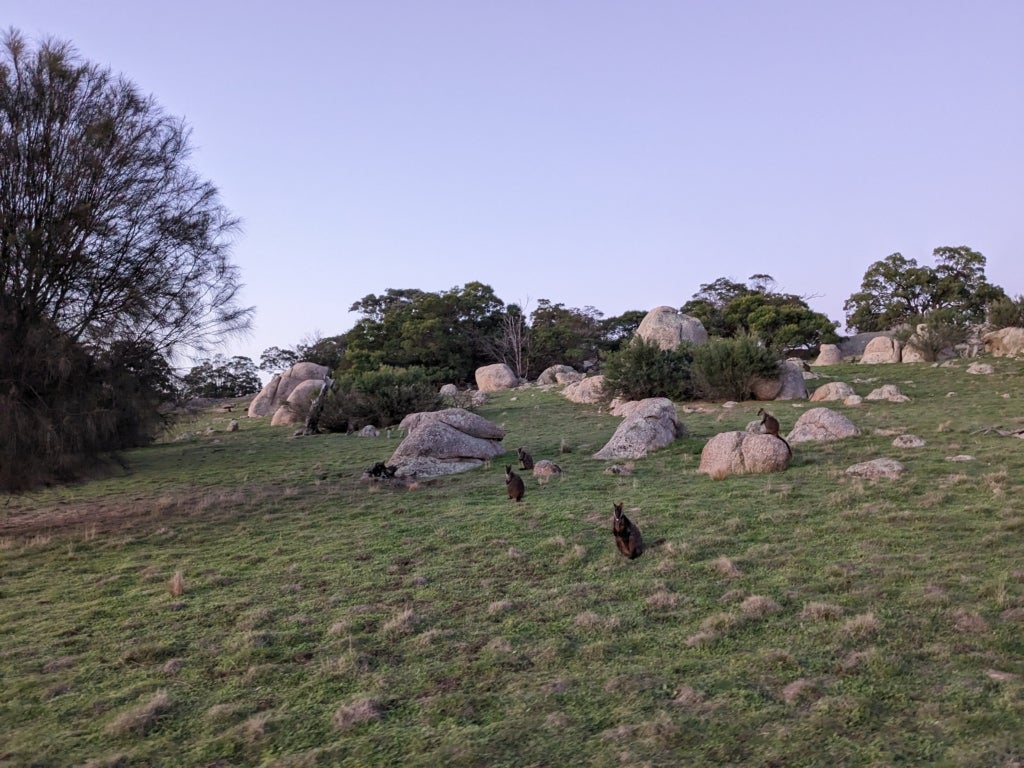Back from the Brink: Feral Predator-Free Ecosystems in Australia Bring Back Endangered Wildlife
Cecilia Riebl – ILCN Regional Representative for Australasia
On a fine fall afternoon in June 2024, a group of conservation policy makers from Australia and the United States met at the conservation and research reserve Mt Rothwell, just 50 kilometers from Melbourne, Australia. As dusk fell over the shrub- and rock-dotted landscape around them, animals began to appear: the Eastern barred bandicoot, the Southern brush-tailed rock-wallaby, and the Eastern quoll. Each of these species is listed as endangered or extinct in the wild, but here they are thriving.

Nestled in the foothills of the You Yangs Regional Park, Mt Rothwell is the largest feral predator-free ecosystem in Victoria. Managed by the environmental charity Odonata, its mission is to protect the site’s remnant habitat and restore the natural ecosystems, to allow indigenous, high-conservation value plants and animals to recover and flourish.
The sanctuary is succeeding in this mission. The 473-hectare (about 1,169-acre) enclosure has eradicated cats and foxes and enhanced native vegetation, allowing native mammal species to be reintroduced and grow their populations naturally.
The sanctuary currently supports approximately 80 percent of the mainland Eastern barred bandicoot population. These rabbit-sized marsupials are uniquely well-adapted to the harsh environmental pressures of Australia. Nonetheless, before 2021, the species was listed as extinct in Victoria. In that year, Mt Rothwell’s work resulted in the species being reclassified to endangered.
Mt Rothwell also has the most successful captive breeding program for the Eastern quoll—a type of carnivorous marsupial about the size of a small domestic cat that is important for pest control—which is presumed extinct in mainland Australia. Apex predators such as the Eastern quoll and spot-tailed quoll have been reintroduced to balance the ecosystem.
The conservationists visiting Mt Rothwell in June included the International Land Conservation Network’s director, Jim Levitt and associate director, Chandni Navalkha. “This is an extraordinary place,” said Levitt. “It tells us that nature can recover when the threats are removed; and showcases a scalable model for recovery”.
Mt Rothwell has been scaling—Odonata is responsible for several other sanctuaries across Australia’s south-east region, including Tiverton Farm Sanctuary—a 1,000-hectare (about 2,471-acre) regeneratively managed working farm—home to Eastern barred bandicoots and Eastern quolls, which have been reintroduced to this landscape for the first time in over 70 years.
Other sanctuaries managed by government or other not-for-profit organizations—including Mt Rothwell’s sister sanctuary Mulligan’s Flat in the Australian Capital Territory—are supporting Odonata’s work by bringing back many native species from the brink of extinction, including sugar gliders, possums, echidnas, and swamp wallabies.

Odonata’s approach to scaling its model is built around its 500-in-5 Species-led Ecosystem Recovery Plan, known as 500-in-5. The plan was developed on the premise that once a population has been rebuilt back to at least 500 individuals dispersed in genetically diverse groups across at least five strategically identified sanctuaries, the species has recovered to viable levels, insuring against the threat of climate change, predation, natural disasters, and poor genetics.
“500-in-5 has the power to save species, place significantly more land under restoration and inform the future of biodiversity credits by taking a full-ecosystem approach to land regeneration,” said Samuel Marwood, Odonata CEO. “We currently have six operating sanctuaries in our network and are fundraising and building landholder partnerships to further scale our work across Australia, and internationally”.
The threats to Australia’s endangered and other threatened species are many and varied. The leading causes are habitat destruction, feral predators, and urban development. Other new and evolving challenges lie ahead, including climate change and climate-induced natural disasters.
At the same time, new opportunities are emerging. Innovative nature-based solutions are currently being explored that could bring wind and solar farms together with predator-free sanctuaries, creating networks and corridors across the Australian landscape. The story of the Earth’s biodiversity will be determined, in part, by society’s ability to keep pace with threats in scaling and funding these innovations.
As darkness fell across the Victorian Volcanic Plains, visitors to Mt Rothwell used torches to navigate their way through native vegetation and up to the rocky granite outcrops. Annette Rypalski, General Manager at Mt Rothwell, and Biodiversity Director at Odonata, deftly handled a Southern brush-tailed rock-wallaby, inserting a microchip, taking a swab to test her genes, and identifying a special package— a tiny hairless joey growing to maturity in the safety of the pouch. “That’s our future right there”, said Rypalski, and then carefully passed the wallaby to Levitt, who released it into the night.
Have news? Share updates from your organization or country by emailing ilcn@lincolninst.edu.
